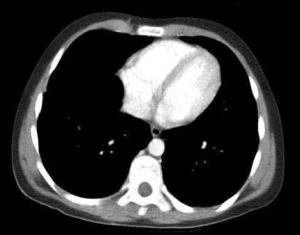by
Joanna Padovano, Reporter | August 25, 2011
CT radiation dosage can be decreased by up to 30 percent during the screening of lung nodules, according to "CT Screening and Follow-Up of Lung Nodules: Effects of Tube Current Time Setting and Nodule Size and Density on Detectability and of Tube Current-Time Setting on Apparent Size." The study was conducted at Stanford University and the University of Bern in Switzerland, and it will appear in the September 2011 issue of the American Journal of Roentgenology.
Using 50 patients who had been referred for cancer staging, lung nodule screening, or follow-up screening, radiologists examined chest CT images at various dosage levels, ranging from 300 mAs-the current standard-to 5 mAs. They examined 125 cuboidal regions that displayed a single nodule. The control group consisted of nine patients with a total of 27 normal cuboids.
The data, acquired by the Somatom Sensation, a 64-MDCT scanner manufactured by Siemens Healthcare, was collected between January and March of 2009. Without the usage of IV contrast material, all of the patients were scanned in the supine position at 300 mAs. Those images were then reconstructed at a dozen descending levels of dosage.



Ad Statistics
Times Displayed: 175654
Times Visited: 3192 For those who need to move fast and expand clinical capabilities -- and would love new equipment -- the uCT 550 Advance offers a new fully configured 80-slice CT in up to 2 weeks with routine maintenance and parts and Software Upgrades for Life™ included.
One of the study's conclusions was that tube current-time settings could be reduced to 10 mAs without impairing the diagnostic image quality. "The tube current-times levels of 10, 20, 30, 40, and 100 mAs did not exhibit a significant difference in individual reader sensitivity compared with the standard 300 mAs," write the authors. "The readers had one thing in common: Sensitivity for all 125 nodules was not significantly influenced by dose level."
A decreased current-time setting would be beneficial to patients because a smaller amount of radiation exposure would lower the threat of deadly cancer caused by radiation. "The risk of radiation-induced cancer death for one standard chest CT examination is estimated at approximately 1:4000 and may hypothetically be reduced to 1:120,000 if a linear relation between dose and risk of cancer death is assumed," write the authors. "A low-dose protocol would be of special interest to patients with lung nodules because the cumulative radiation dose of repetitive follow-up CT examinations might be reduced considerably."
The study also indicates that using a computer to assist with volume measurements in follow-up lung nodules lessened the variability, as opposed to when radiologists perform measurements by hand. "Much better inter-reader agreement was found for the computer-aided lesion measurement solution than for manual measurements," write the authors. "The manual volume measurement in our study was much more influenced by inter-reader variability than by variability of tube current-time level or intraobserver variability."
Back to HCB News

